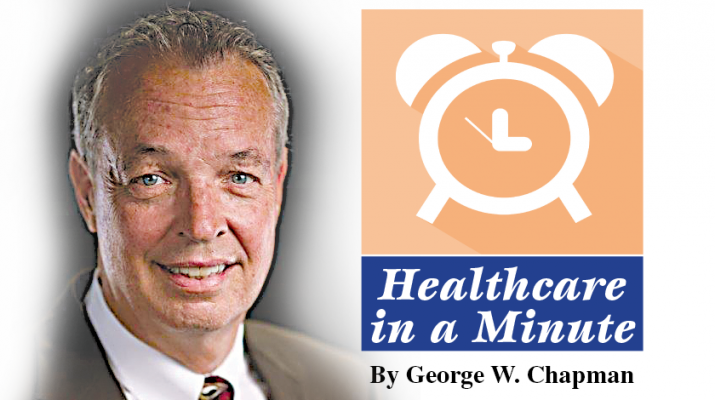By George W. Chapman
Whether hospitals or insurance companies, most consolidations have resulted in fewer choices and higher prices for consumers. The healthcare watchdog group The Commonwealth Fund estimates 90 percent of metropolitan statistical areas are “highly” or “super” consolidated. While some consolidations should create economies of scale and lower prices, most have resulted in market dominance and price increases. Many experts believe that the government’s attempts to foster competition may be too late. To boost competition, the FTC needs greater resources to evaluate proposed consolidations and then to break them up if prices go up and consumers choices go down. In defense of hospitals, most are operating precariously close to break-even and the very survival of some hospitals, especially in rural areas, may depend on merging with a larger hospital system. If hospitals do not consolidate in markets dominated by a single insurer/payer, they will lose negotiating power. Moody Investor Services paints a semi-gloomy outlook for 2019. Hospitals are experiencing decreasing inpatient operating revenues as more and more care transitions to outpatient venues. Hospitals are also facing competition from new, non-traditional providers like for-profit urgent care centers, retail store based clinics and independent physician operations. New players in the industry, like Google, Amazon and Apple are determined to drive down costs and reinvent how care is delivered.
Feds Fostering Competition In Healthcare
Responding to an executive order from the President, a working group of members from the departments of HHS, Labor and Treasury issued a 119-page report on how to promote choice and competition in our healthcare system. Among some of the recommendations/suggestions were: broaden the scope practice for nurse practitioners, physician assistants and hygienists so they can be paid directly and operate with less physician supervision; increase reimbursement for telemedicine; allow multistate medical licenses and across state lines for telemedicine; reallocate funding for residency programs based on the most in demand specialties like family practice, pediatrics, internal medicine, OB-GYN and psychiatry; reduce restrictions on physician-owned hospitals (none in NYS); allow hospitals to expand or contract without certificate of need approval from the state; scale back the ACA’s employer insurance mandates; expand the use of health savings accounts to all, including those on Medicare; increase price transparency; make it easier for patients to access their records. Reactions from the American Hospital Association and the American Medical Association were both expected and mixed.
Telemedicine Increasing
According to the AMA, telemedicine has been embraced the most by radiologists (40 percent), psychiatrists (28 percent) and cardiologists (24 percent). The average across all specialties is 15 percent. The acceptance of telemedicine is expected to increase due to a shortage of physicians, reduced costs for the technology, consumer preference and improved reimbursement to physicians. It is far too early to tell what the long range impact of telemedicine is on a person’s overall health versus face to face office encounters.
NYS Bans Short-Term Plans
With the slow dismantling of the ACA and associated penalties for not having insurance, many states are allowing the sale of cheap, short-term health insurance good for three years. NYS is not one of them. The ACA mandated minimum coverage/benefits for bronze, silver and platinum plans. So consumers could confidently shop around for the best price because all insurers had to offer the same mandated benefits per bronze, silver or platinum plan. Short-term plan shopping is a gamble because you have to compare both price and benefits across divergent plans. As with anything else, you will get what you pay for. Short-term plans do not cover pre-existing conditions.
Primary Care Physician Visits Decline
According to a study of claims data from 2012 to 2016, the Healthcare Cost Institute reported an 18 percent decrease in office visits to primary care physicians. Visits to advanced practitioners, (nurse practitioners and physician assistants), increased a staggering 129 percent over the same four years. There is plenty of speculation why. Since more medical students are favoring specialties over primary care, the influx of new primary care physicians into the market is declining while older primary care physicians are retiring. Consequently, the role of APs in providing primary care, by necessity, has increased. Convenience may be a factor. Younger/healthy patients don’t want to wait for an appointment with their physician, so gladly schedule sooner with an AP. Many consumers are electing to get primary care from walk-in retail clinics or urgent care centers which are staffed primarily with APs. Finally, more and more states are loosening their requirements for physician supervision of APs, allowing the APs more latitude in scheduling patients.
Top Healthy New Year’s Resolutions
We all make them. Here are the most popular ones regarding health: More exercise, 38 percent; lose weight, 33 percent; eat healthy, 32 percent; be more active, 15 percent; learn a new skill/hobby; spend more time on personal well-being; consume less alcohol; stop smoking. By picking just one, you will accomplish some of the others.
George W. Chapman is a healthcare business consultant who works exclusively with physicians, hospitals and healthcare organizations. He operates GW Chapman Consulting based in Syracuse. Email him at gwc@gwchapmanconsulting.com.

